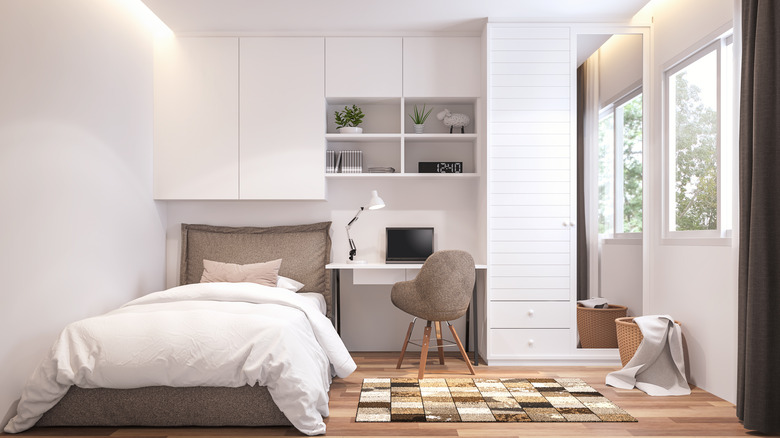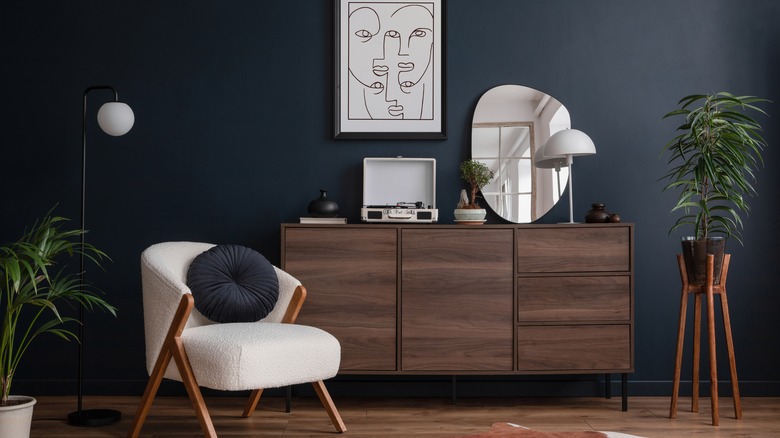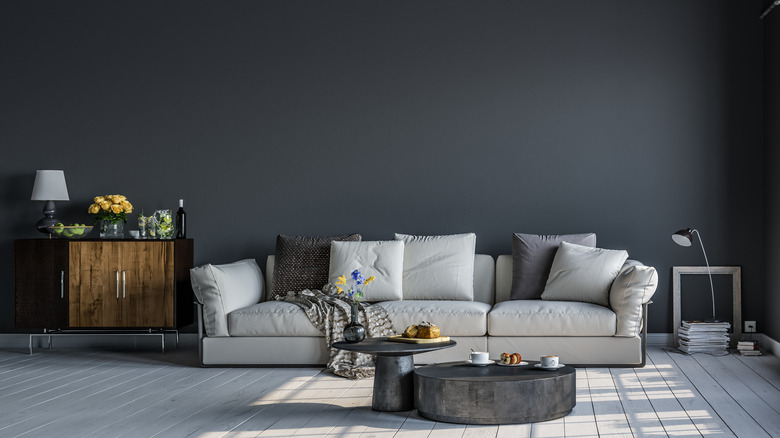The Best Type Of Paint To Make A Small Space Feel Bigger, According To Bobby Berk
Even if your home wasn't blessed with a huge floor plan, expansive open living areas, or vaulted ceilings, that doesn't mean you should have to live in a space that feels cramped. Fortunately, there are several design techniques you can utilize to help make your small living space feel larger and more open — one of the simplest and easiest being the strategic use of paint.
While paint can help set the tone of your living space through the use of color, other factors, like the shade and the sheen of the paint you choose, can also manipulate light to trick the eye into perceiving a confined space as being much larger. It can also have the opposite effect if you aren't careful. According to interior designer and star of Netflix's "Queer Eye," Bobby Berk, you can use either white paint or carefully and intentionally use dark paint, specifically one with a more matte sheen, to help a small room feel larger.
Four white walls is a foolproof option
As a general rule of thumb, painting the walls of a small room with a shade of white is an easy, foolproof way to make any small space feel more open. According to Berk, the light, neutral hue makes the space look bigger and brighter.
Though Berk asserts that white paint can aid in opening up your cramped space, that doesn't mean you need to continue the theme of white throughout the rest of your space to try and match the neutral paint shade. In fact, please don't do this — unless you want your room to feel as sterile and cold as a hospital waiting room. Painting your walls white simply guarantees they will lend themselves to helping the room feel brighter and more open while inviting you to implement color in other ways. "Bring in your personality through the colors in the rugs, pillows, and a little bit of wallpaper," Berk says (per Homes & Gardens).
It's also best not to break up your small space even more by painting the walls different colors. "When working with a smaller space, try to make all the walls the same color," Berk says. "People are often tempted to break up a room with color-blocking or by sectioning off spaces in an attempt to make it feel larger," he adds (via Elle Decor), noting that this can actually have the opposite effect.
When going dark, opt for monochromatic
While white is usually the most guaranteed option to open a small, cramped space, it's possible to use a bold, dark tone to make your space feel larger. Despite the common misconception that you should avoid dark paint colors to keep the walls from visually swallowing the room's open space, when strategically used, darker paint hues can actually help your room feel more expansive. "[It] can sometimes even make the room appear larger and more dramatic," says Berk (via Bobby Berk), reiterating the importance of being careful when using dark paint in a small room, as it can have the opposite effect if done incorrectly. "If you decide to go dark with your walls then keep things more monochromatic elsewhere. The drama will come in through the dark color on your walls so you don't need to bring in a lot of other color or pattern."
If the room you are painting is particularly small, keeping any accent and décor pieces within the same tonal family as the paint is a good idea. Berk recommends using a maximum of four colors in the room. "That doesn't mean that it can't be colorful, but that does mean to stick to a tonal palette, whether that be cool tones like blues and greens, or warmer tones like terracotta, beige, and rusts. By keeping things within the same tonal palette, the space will feel larger and more cohesive, which will allow it to feel less disjointed."
Pay attention to sheen
While painting the four walls of your small room a shade of white or opting for a dark, monochromatic scheme can help it feel more open and expansive, it's also important to consider the sheen of whatever paint tone you choose.
If you are going with darker paint, Berk recommends choosing a matte finish like flat or eggshell. "The matte finish will help to hide imperfections in the wall which will help the dark color feel more expansive visually," he says (via Bobby Berk). Matte finishes in a dark room help conceal the edges and corners, giving the illusion that the room has no bounds. A flat or eggshell finish also helps hide any imperfections in the finish of the wall, which remind the eye that the wall is close by. Camouflaging those imperfections creates the illusion that the dark color on the walls is nothing more than a vast openness that stretches beyond what you can see. Pretty cool, huh?
White paint, on the other hand, usually calls for more of a glossy finish, such as satin, as the reflective quality can help the light reflect around the room, aiding in making it feel brighter and more open. Additionally, Berk explains that you can also paint your doors, trim, and ceiling the same color as your walls to help the room feel larger, which also works by causing the edges and walls of the room to look like they aren't even there (via Bobby Berk).



